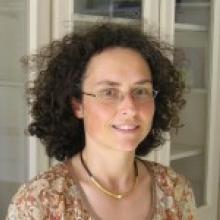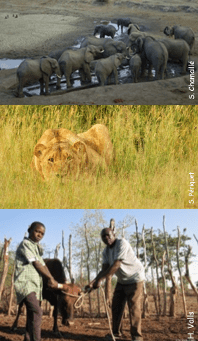Quantitative and Evolutionary Ecology of Communities Group
Members

Doctorante
UCBL

Professeure des universités
VetAgro-Sup
Tel: 33 04 72 43 27 56

Directeur de recherche
CNRS
Tel: 33 04 72 43 27 57

Doctorant
UCBL
Tel: 04 72 44 81 42

Doctorant
CNRS
Tel: 04 72 44 81 42
Doctorant
VetAgro-Sup

Maître de conférences
UCBL
Tel: 04 72 44 81 42


Professeur des universités
UCBL
Tel: 33 04 72 43 27 56

Professeur des universités
UCBL

Directeur de recherche
CNRS
Tel: 33 04 72 43 27 56

Maîtresse de conférences
UCBL
Tel: 33 04 72 43 29 02
Maître de conférences
UCBL
Tel: 33 04 72 43 29 02

Our research activities, focused on interspecific interactions (community ecology), aim to better understand the ecological and evolutionary processes structuring species assemblages and biodiversity at different temporal and spatial scales. Our team addresses these major issues using contrasting biological models (communities of large African mammals, insects, microbiota, plants) from 3 complementary angles:
- Our work is strongly anchored in the conceptual framework of evolutionary biology by studying (i) the diversity of adaptive responses implemented by organisms to selective pressures in their environment, (ii) their consequences on population demography and ultimately (iii) the dynamics and composition of species communities.
- Our research is closely linked to societal issues of biodiversity conservation and management by integrating both the functioning of socio-ecological systems and the context of climate change. We conduct experimental studies, manage and ensure the long-term monitoring of several community observation networks.
- Methodological issues also occupy a central place in our team, with the development of new tools for statistical processing and modeling of ecological data. This activity leads to the development of methods and software that we develop and distribute freely.
Research programs

Functioning of African savanna communities
The Hwange LTSER (Long-Term Socio-Ecological Research site in Zimbabwe hosts a long-term interdisciplinary research program that focuses on the functioning of plant and animal communities within the Hwange National Park and the interactions between this protected area and humans living in its periphery. Based on this program, three axes are developed: (1) studying the population dynamics of elephants, exploring their impact and that of management policies on the socio-ecosystem functioning; (2) Understanding the extent to which interactions within and between trophic levels are sensitive to management actions (e.g. sport hunting, water management) and climate change; (3) Decoding human ecology and human-wildlife coexistence mechanisms towards integrated conservation and sustainable functioning of the socio-ecosystem. This research is complemented by more recent works in the Hluhluwe-iMfolozi Park and in the Madikwe reserve in South Africa, which focus on the role of environmental conditions on the hunting success of large African carnivores. We work in close collaboration with the IRL (International Research Lab) Rehabs.
Involved group members : Alice Bernard, Laura Lacomme, Aïssa Morin, Lisa Nicvert, Elie Pedarros, Yolan Richard, Marion Valeix*

Masting and the community dynamics of seed consumers
Masting is a reproductive strategy often encountered in perennial plants, characterized by fructifications highly fluctuating in time and being synchronized at the population level. The seeds produced that way constitute a pulsed resource with a strong impact on the eco-evolutionary dynamics of seed-consuming communities and forest regeneration. Our lack of knowledge of this system still impedes our understanding of the dynamics of temperate forest ecosystems and its future in the context of climate change. Our work carried out on oak forests aims to better understand (i) the proximal causes of masting, (ii) the mechanisms underlying the coexistence of species competing for such highly fluctuating resource and (iii) the co-evolution of consumer exploitation strategies for the fluctuating resource and forest tree fruiting strategies. On the basis of the results obtained, scenarii will be proposed on the future of forest regeneration under climate change, that may serve forest management.
Involved group members : Marie-Claude Bel-Venner*, Emilie Fleurot, Léa Keurinck, Jean Lobry, Samuel Venner

The spread of antibiotic resistance genes in bacteria
Antibiotic resistance is recognized as one of the greatest current threats to human health, and the mobile genetic elements (MGEs) that circulate in bacterial populations and communities are the main vehicles. To understand the dynamics and diversity of MGEs in bacterial pangenomes and the emergence of antibiotic resistance genes, we propose to go beyond the framework of conventional genomics by considering pangenomes as complex ecological communities. In the Ab-One program, we mobilize the concepts and tools developed in community ecology based on an integrative approach (monitoring of bacterial populations/communities evolving in contrasting environments -One-Health approaches-, pan-genomic analyses, experimentation in molecular and cellular microbiology, mathematical modelling). This program is currently focused on the dynamics of MGEs in Acinetobacter baumannii, an antibiotic-resistant microorganism classified as a priority by the WHO. Other more general approaches will illustrate the relevance of this new conceptual framework to understand the dynamics and diversity of MGEs in bacterial pangenomes. This program, co-piloted by our team and a team from CIRI (Horigene) involves the participation of 9 organizations (6 from Lyon -LBBE, CIRI, MMSB, HCL, LEM, VetAgro Sup-, Institut Pasteur (Paris), LMGM (Toulouse ), Robert Koch Institute (Germany)).
Involved group members : Stéphane Dray, Rémi Tuffet, Samuel Venner*

Statistical analysis of ecological data
Understanding the structure and dynamics of species assemblages, and the processes behind them, requires collecting data that are becoming increasingly complex owing to the sophisticated technological developments made available for their acquisition (e.g. GPS, loggers, satellite imagery, molecular data). We are developing new methods for analysing such data, that provide new insights into the ecological processes at work in communities. Multivariate analysis methods allow the analysis of spatial structures, accounting for various information on species (functional traits, morphology, phylogeny), the spatio-temporal variation of species-environment relationships or the multifaceted perception of the protected human-environment relationship. We also model multi-'omics' dose-response data within communities in order to better understand the Adverse Outcome Pathway (AOP) and to better appreciate the risks to the environment. These methodological innovations are made available to the scientific community through the development, distribution and maintenance of software (libraries for the R language: ade4, adegraphics, adephylo, ade4TkGUI, nlstools, fitdistrplus, DRomics, seqinr).
Involved group members: Marie Laure Delignette-Muller, Stéphane Dray*, Jean Lobry, Jean Thioulouse.
Publications
Display of 571 to 600 publications on 656 in total
Within-plot relationships between tree species occurrences and hydrological soil constraints: an example in French Guiana investigated through canonical correlation analysis
Plant Ecology . 162 : 143-156
Journal article
see the publicationA mathematical method for determining genome divergence and species delineation using AFLP
International Journal of Systematic and Evolutionary Microbiology . 52 : 573-586
Journal article
see the publicationA mathematical method for determining genome divergence and species delineation using AFLP
International Journal of Systematic and Evolutionary Microbiology . 52 : 573-586
Journal article
see the publicationThe diet of feral cats (Felis catus L.) at five sites on the Grande Terre, Kerguelen archipelago
Polar Biology . 25 : 833-837
Journal article
see the publicationEstimation of the Web's capture thread lenght in orb-weaving spiders: determining the most efficient formula.
Annals of the Entomological Society of America . 94 : 490--496
Journal article
see the publicationExperimental and theoretical evaluation of typing methods based upon random amplification of genomic restriction fragments (AFLP) for bacterial population genetics
Genetics Selection Evolution . 33 : S319-S338
Journal article
see the publicationEstimation of the Web`s capture thread lenght in orb-weaving spiders: determining the most efficient formula.
Annals of the Entomological Society of America . 94 : 490-496
Journal article
see the publicationOptimal growth temperature of O157 and non-O157 Escherichia coli strains
Letters in Applied Microbiology . 33 : 352-356
Journal article
see the publicationCharacterization of bacterial and fungal soil communities by automated ribosomal intergenic spacer analysis fingerprints: biological and methodological variability.
Applied and Environmental Microbiology . 67 ( 10 ) : 4479-87
Journal article
see the publicationExperimental and theoretical evaluation of typing methods based upon random amplification of genomic restriction fragments (AFLP) for bacterial population genetics
Genetics Selection Evolution . 33 ( 1 ) : 319-338
Journal article
see the publicationCharacterization of bacterial and fungal soil communities by automated ribosomal intergenic spacer analysis fingerprints : biological and methodological variability
Applied and Environmental Microbiology . 67 ( 10 ) : 4479-4487
Journal article
see the publicationThe mycorrhizal soil infectivity and arbuscular mycorrhizal fungal spore communities in soils of different aged fallows in Senegal
Applied Soil Ecology . 17 : 239-251
Journal article
see the publicationMycorrhizal soil infectivity and AM fungal spore communities of different aged fallows in Senegal
Applied Soil Ecology . 17 : 239-251
Journal article
see the publicationSuccessional trends in the characteristics of soil nematodes communities in cropped and fallow lands in Senegal (Sonkorong)
Applied Soil Ecology . 14 : 5-15
Journal article
see the publicationA soil microscale study to reveal the heterogeneity of Hg (II) impact on indigenous bacteria by quantification of adapted phenotypes and analysis of community DNA fingerprints
FEMS Microbiology Ecology . 31 : 107-115
Journal article
see the publicationRecherche de méthodes de gestion des peuplements de nématodes phytoparasites par les facteurs du sol en zone soudano-sahélienne au Sénégal
Étude et Gestion des Sols . 7 ( 4 ) : 261-270
Journal article
see the publicationRelationships between abiotic and biotic soil properties during fallow periods in the sudanian zone of Senegal
Applied Soil Ecology . 14 : 89-101
Journal article
see the publicationWeb-building behavior in an orb-weaving spider Zygiella x-notata: influence of experience
Animal Behaviour . -- : 603-611
Journal article
see the publicationBiological variability and exposure assessment
International Journal of Food Microbiology . 58 : 203-212
Journal article
see the publicationOriloc: prediction of replication boundaries in unannotated bacterial chromosomes
Bioinformatics . 16 : 560-561
Journal article
see the publicationAnalyzing DNA strand compositional asymmetry to identify candidate replication origins of Borrelia burgdorferi linear and circular plasmids
Genome Research . 10 : 1594-1604
Journal article
see the publicationArtificial intelligence and meaning--some philosophical aspects of decision-making
Acta Biotheoretica . 48 : 173-179
Journal article
see the publicationDetermination of parotid urea secretion in sheep by means of ultrasonic flow probes and a multifactorial regression analysis
Journal of Animal Science . 78 : 471-476
Journal article
see the publicationBiological variability and exposure assessment
International Journal of Food Microbiology .
Journal article
see the publicationA soil microscale study to reveal the heterogeneity of Hg(II) impact on indigenous bacteria by quantification of adapted phenotypes and analysis of community DNA fingerprints
FEMS Microbiology Ecology . 31 ( 2 ) : 107-115
Journal article
see the publicationEctomycorrhization of six Acacia auriculiformis provenances from Australia Papua New Guinea and Senegal in glasshouse conditions: effect on the plant growth and on the multiplication of plant parasitic nematodes
Australian Journal of Experimental Agriculture . 40 : 443-450
Journal article
see the publicationHeterogeneous Cell Density and Genetic Structure of Bacterial Pools Associated with Various Soil Microenvironments as Determined by Enumeration and DNA Fingerprinting Approach (RISA)
Microbial ecology . 39 : 263-272
Journal article
see the publicationDiversity of the bacterial hyperparasite Pasteuria penetrans in relation to the control of root-knot nematodes (Meloidogyne spp.) on Acacia holosericea
Nematology . 2 : 435-442
Journal article
see the publicationIdentification of birds as biological markers along a neotropical urban-rural gradient using co-inertia analysis
Journal of Environmental Management . 59 : 121-140
Journal article
see the publicationHeterogeneous cell density and genetic structure of bacterial pools associated with various microenvironments as determined by enumeration and DNA fingerprinting approach (RISA)
Microbial ecology . 39 : 263-272
Journal article
see the publication
You also, comment on this article